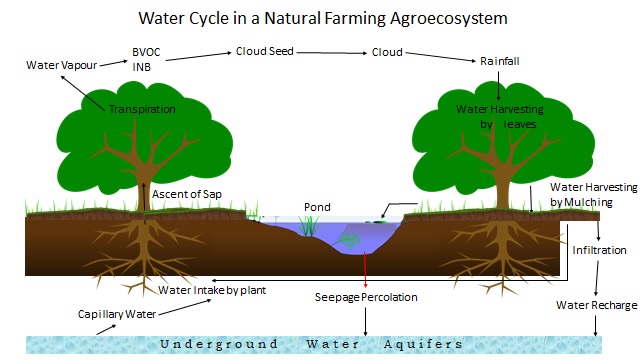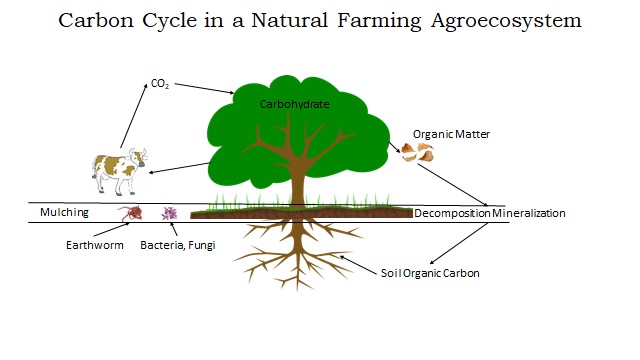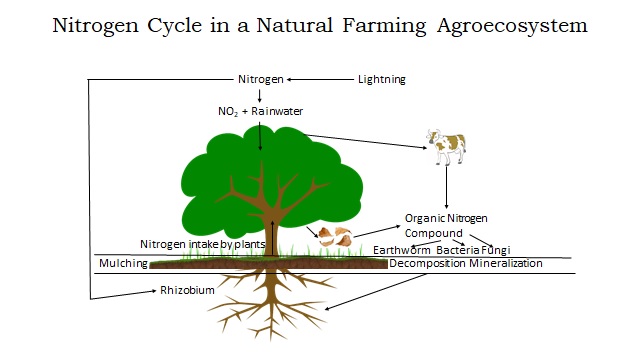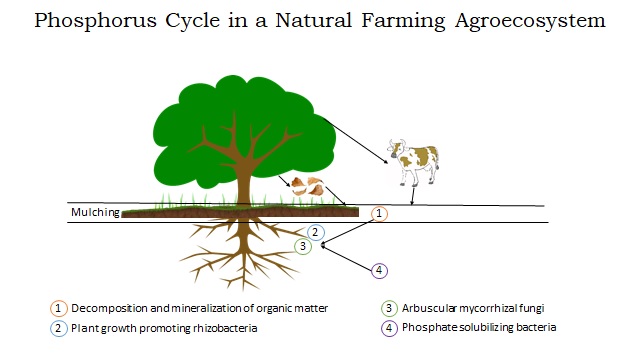Provisioning Ecosystem Services:
Natural farming agroecosystems provide various direct material benefits to man such as food, medicine, fibre, and fuel. Farm management efficiency is determined by the yield of these provisioning ecosystem services per unit area per unit of time.
Regulating Ecosystem Services:
Natural farming agroecosystem provides various indirect benefits to man by regulating various biogeophysical cycles (such as temperature cycle and water cycle) and biogeochemical cycles (such as carbon cycle, nitrogen cycle, phosphorus cycle, and potassium cycle), that provides water and nutrients to plants. The biodiversity of organisms (predators, parasites, and competitors) in the natural farming agroecosystem regulates the natural control of insect pests, diseases, and weeds for crop protection.
Water Cycle (Hydrological Cycle):
Within a natural farming agroecosystem, water moves through the atmosphere (air), biosphere (plants and animals), and geosphere (soil) automatically to form a complete cycle. The plant biodiversity uptakes water from the soil through plant roots, releases water in the atmosphere through stomata in leaf surface (transpiration), induces cloud seeding, induces rainfall, harvest rainwater, reduces runoff, increases infiltration of rainwater in soil, and enhances the recharge of water in the underground aquifers. Animals drink water from freshwater sources and get water from plants. Natural farming uses mulching and cover cropping to moderate soil temperature and to reduce evapotranspiration from soil surface, thus maintaining the soil water level constantly at field capacity throughout the year, to enable optimum growth and development of plant biodiversity. There is no need to apply irrigation water to crop plants in a natural farming agroecosystem.

Carbon Cycle:
In a natural farming agroecosystem, carbon moves through the atmosphere, biosphere, and geosphere to represent a complete cycle. Green plants capture carbon from the atmosphere to prepare carbohydrates through photosynthesis. Animals eat plants and carbon transfers from plants to animals. When plants or animals drop the organic matter or die, carbon compounds return to the soil. Soil microorganisms decompose and mineralize these carbon compounds and make them ready for uptake by plants or storing the carbon in the soil. On the other hand, plant and animal respiration and decomposition of organic matter release carbon in the atmosphere in the form of carbon dioxide and methane. Natural farming agroecosystems aim to maximize the synthesis of organic biomass through plant biodiversity and to maximize carbon capture in the soil through mulching and cover cropping, which help mitigate climate change.

Nitrogen Cycle:
Nitrogen is an inert gas in the atmosphere that passes through the atmosphere, biosphere, and geosphere, in the natural farming agroecosystem, to form a complete cycle. During lightning in the atmosphere, nitrogen gas is oxidized to form nitrate compounds that dissolve in rainwater and drop on soil or plant leaves. Plant leaves can absorb these nitrate compounds directly from rainwater. Plants belonging to the Fabaceae family (legume crops) form symbiotic associations with Rhizobium bacteria in their root nodules and fix atmospheric nitrogen to form nitrate compounds. Other free-living bacteria in the soil (such as Azotobacter) can also fix atmospheric nitrogen into nitrogen compounds. On the other hand, denitrifying bacteria reduce nitrate or ammonia into nitrogen and release it into the atmosphere. As nitrogen is an essential element for plant growth, natural farming explores all possible means to maximize nitrogen capture from the atmosphere. Farmers maximize plant biodiversity and leaf area index (LAI) in the natural farming agroecosystem to harvest maximum rainwater and absorption of nitrogen through plant leaves. They include legume crop biodiversity to maximise fixing of atmospheric nitrogen in plant roots and they use mulching and cover cropping to create congenial habitat for microorganism biodiversity to maximise the fixation of atmospheric nitrogen in soil, for optimum plant growth and development.

Phosphorus Cycle:
Phosphorus occurs only in the geosphere and biosphere. Microorganism biodiversity in soil such as arbuscular mycorrhizal fungi (AMF) and plant growth promoting rhizobacteria (PGPR) can solubilise organic and inorganic phosphorus in soil and help plants to uptake phosphorus. This phosphorus again returns to the soil through the decomposition of plant and animal dropping and dead bodies. Natural farming agroecosystems ensure optimum availability of phosphorus to the crop plants solely from organic sources by recycling organic matter (mulching) through microbial decomposition and mineralization, to avoid the use of inorganic phosphorus from soil minerals.

Cultural Ecosystem Services:
Natural farming agroecosystems provide various non-physical indirect benefits to man such as recreation, aesthetic appreciation, and religious fulfilment which are known as cultural ecosystem services. Farmers monetize these cultural ecosystem services through eco-agritourism.